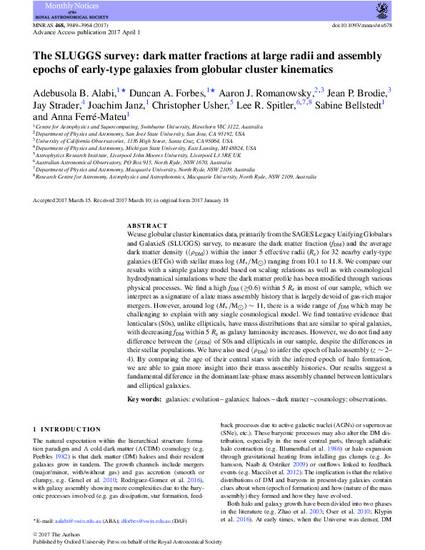
Article
The SLUGGS survey: dark matter fractions at large radii and assembly epochs of early-type galaxies from globular cluster kinematics
Monthly Notices of the Royal Astronomical Society
(2017)
Abstract
We use globular cluster kinematics data, primarily from the SAGES Legacy Unifying Globulars and GalaxieS (SLUGGS) survey, to measure the dark matter fraction (fDM) and the average dark matter density (〈ρDM〉) within the inner 5 effective radii (Re) for 32 nearby early-type galaxies (ETGs) with stellar mass log (M*/M⊙) ranging from 10.1 to 11.8. We compare our results with a simple galaxy model based on scaling relations as well as with cosmological hydrodynamical simulations where the dark matter profile has been modified through various physical processes. We find a high fDM (≥0.6) within 5 Re in most of our sample, which we interpret as a signature of a late mass assembly history that is largely devoid of gas-rich major mergers. However, around log (M*/M⊙) ∼ 11, there is a wide range of fDM which may be challenging to explain with any single cosmological model. We find tentative evidence that lenticulars (S0s), unlike ellipticals, have mass distributions that are similar to spiral galaxies, with decreasing fDM within 5 Re as galaxy luminosity increases. However, we do not find any difference between the 〈ρDM〉 of S0s and ellipticals in our sample, despite the differences in their stellar populations. We have also used 〈ρDM〉 to infer the epoch of halo assembly (z ∼ 2–4). By comparing the age of their central stars with the inferred epoch of halo formation, we are able to gain more insight into their mass assembly histories. Our results suggest a fundamental difference in the dominant late-phase mass assembly channel between lenticulars and elliptical galaxies.
Keywords
- galaxies: evolution,
- galaxies: haloes,
- dark matter,
- cosmology: observations
Disciplines
Publication Date
July, 2017
DOI
10.1093/mnras/stx678
Publisher Statement
This article was originally published in Monthly Notices of the Royal Astronomical Society, ©: 2017 The Authors. Published by Oxford University Press on behalf of the Royal Astronomical Society. All rights reserved.
This article can also be found online at the following link: https://doi.org/10.1093/mnras/stx678
Citation Information
Adebusola B. Alabi, Duncan A. Forbes, Aaron J. Romanowsky, Jean P. Brodie, et al.. "The SLUGGS survey: dark matter fractions at large radii and assembly epochs of early-type galaxies from globular cluster kinematics" Monthly Notices of the Royal Astronomical Society Vol. 468 Iss. 4 (2017) p. 3949 - 3964 ISSN: 0035-8711 Available at: http://works.bepress.com/aaron_romanowsky/126/
